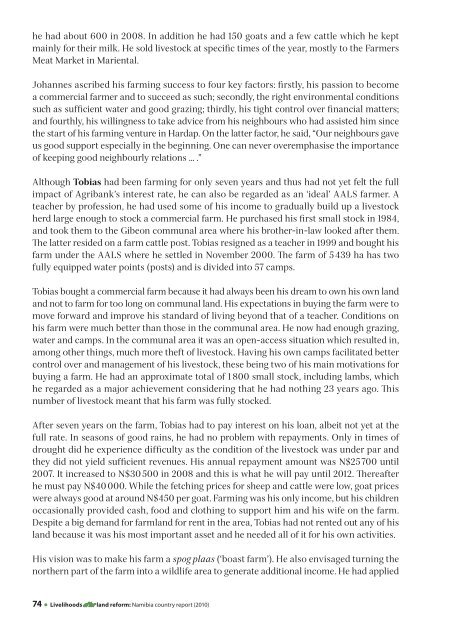Namibia country report
Namibia country report
Namibia country report
- No tags were found...
Create successful ePaper yourself
Turn your PDF publications into a flip-book with our unique Google optimized e-Paper software.
he had about 600 in 2008. In addition he had 150 goats and a few cattle which he keptmainly for their milk. He sold livestock at specific times of the year, mostly to the FarmersMeat Market in Mariental.Johannes ascribed his farming success to four key factors: firstly, his passion to becomea commercial farmer and to succeed as such; secondly, the right environmental conditionssuch as sufficient water and good grazing; thirdly, his tight control over financial matters;and fourthly, his willingness to take advice from his neighbours who had assisted him sincethe start of his farming venture in Hardap. On the latter factor, he said, “Our neighbours gaveus good support especially in the beginning. One can never overemphasise the importanceof keeping good neighbourly relations … .”Although Tobias had been farming for only seven years and thus had not yet felt the fullimpact of Agribank’s interest rate, he can also be regarded as an ‘ideal’ AALS farmer. Ateacher by profession, he had used some of his income to gradually build up a livestockherd large enough to stock a commercial farm. He purchased his first small stock in 1984,and took them to the Gibeon communal area where his brother-in-law looked after them.The latter resided on a farm cattle post. Tobias resigned as a teacher in 1999 and bought hisfarm under the AALS where he settled in November 2000. The farm of 5 439 ha has twofully equipped water points (posts) and is divided into 57 camps.Tobias bought a commercial farm because it had always been his dream to own his own landand not to farm for too long on communal land. His expectations in buying the farm were tomove forward and improve his standard of living beyond that of a teacher. Conditions onhis farm were much better than those in the communal area. He now had enough grazing,water and camps. In the communal area it was an open-access situation which resulted in,among other things, much more theft of livestock. Having his own camps facilitated bettercontrol over and management of his livestock, these being two of his main motivations forbuying a farm. He had an approximate total of 1 800 small stock, including lambs, whichhe regarded as a major achievement considering that he had nothing 23 years ago. Thisnumber of livestock meant that his farm was fully stocked.After seven years on the farm, Tobias had to pay interest on his loan, albeit not yet at thefull rate. In seasons of good rains, he had no problem with repayments. Only in times ofdrought did he experience difficulty as the condition of the livestock was under par andthey did not yield sufficient revenues. His annual repayment amount was N$25 700 until2007. It increased to N$30 500 in 2008 and this is what he will pay until 2012. Thereafterhe must pay N$40 000. While the fetching prices for sheep and cattle were low, goat priceswere always good at around N$450 per goat. Farming was his only income, but his childrenoccasionally provided cash, food and clothing to support him and his wife on the farm.Despite a big demand for farmland for rent in the area, Tobias had not rented out any of hisland because it was his most important asset and he needed all of it for his own activities.His vision was to make his farm a spog plaas (‘boast farm’). He also envisaged turning thenorthern part of the farm into a wildlife area to generate additional income. He had applied74 ● Livelihoods after land reform: <strong>Namibia</strong> <strong>country</strong> <strong>report</strong> (2010)
















